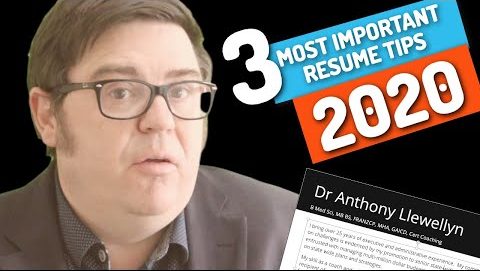I’ve been reflecting back on the thousands of resumes and CVs I’ve reviewed this past year. I’ve been wanting to make a video and post about this topic for some time.
It came to me one morning. I need to give you the three key tips, the three key areas where I see so many people make mistakes, which get in the way of having an effective good, great, even winning CV or resume. So what would be better than to provide you those three best tips for your Resume in 2020? Those tips are 1. Make your name the hero of the document, 2. Don’t use a photograph and finally, the most important one 3. Include a targeted personal profile or executive summary of your career at the top of your resume.
Let’s dive deeper into the reasons why these are the top 3 tips.
6 to 8 seconds to Review a Resume.
So the thing about resumes and CVS is, if you know much about them, then you know that it only takes a recruiter about six, seven or eight seconds to review a resume for the first time. This 6 to 8 seconds is all the time that that recruiter needs to make some sort of decision as to whether they want to talk to you or get you in for an interview.
So it is critical therefore that you focus a lot of your effort on the front page or the first page of your resume. Your resume’s sole job really is to get you that conversation with the recruiter or employer.
Tip 1. Make Your Name the Hero Of Your Resume.
Far too often do I see people putting non-essential words at the top of their resume, like “curriculum vitae” or “resume”. When we actually already know what this document is. So the first tip for maximizing your front page is to get rid of those words and any other erroneous text and just put your name in the biggest, boldest, largest font size letters you can at the top of the page.
Because your name is the “hero” of this document. You’re trying to sell yourself to the employer and the one thing you want them to do is to remember your name.
Tip 2. Get Rid Of That Photo.
Which leads me to the second key point. Think carefully about whether you need a photo on your resume.
Each and every year candidates ask me “should I be including a photo on my resume this year?” My advice this year is the same as before. Don’t include a photo, particularly if you are applying for a job in the professional realm.
Photos are seen as ostentatious and over the top. And the other problem with including a photo on your resume that you don’t know about is if they’ve never seen you before, the recruiter begins to make up all sorts of ideas about you in their mind based on your photo and the recruiter’s unconscious biases, rather than the contents of your CV or resume. And they are spending three or four seconds looking at that photo when they should be spending those three or four seconds out of a total of six to eight seconds reviewing other parts of your resume.
Tip 3. Incorporate An Executive Summary In Your Resume.
My third key point and the thing I see missing so often or poorly executed on CVs or resumes is what some might call the “personal profile” or “career summary”. But what I now like to call the “executive summary”. The bit that sits at the top of your resume right under your name, that takes up about a third or half of the front page that tells your story about who you are, what your career is about, and what you can offer to the employer.
The problem I see is this executive summary is either missing or that candidates are putting bullet points with responsibilities and things that they’ve done in the past that are of no real interest to the employer.
So make sure you tailor that and talk about the sort of knowledge and skills and capabilities that you can bring to the job.
But also think about what can you offer to this employer.
- What do they need?
- Can you offer new leads or new business?
- Can you offer to improve processes and reduce costs?
- Or can you actually create new value for this employer?
Write all that down and put it at the top of your resume.
Hi, I’m Dr. Anthony Llewellyn, otherwise known as the Career Doctor. If you are new to this blog, I make posts and videos on YouTube about the job application process. I am a real medical doctor who knows far too much about the recruitment process. If you want to check out some of my other posts then feel free to have a search around or hop on over to the Career Doctor YouTube channel by clicking on the video attached to this post.


